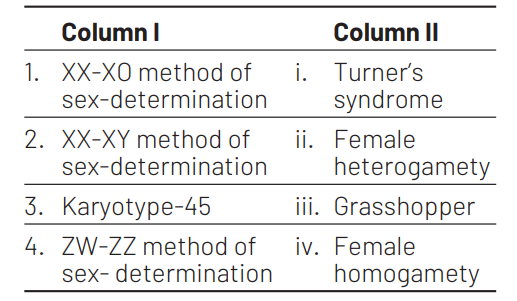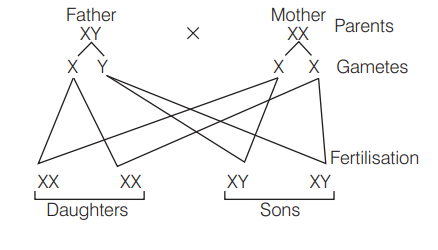Question
Match the items of Column I with Column II. [NEET (Odisha) 2019]

Select the correct option from the following
1 2 3 4
(a) (ii) (iv) (i) (iii)
(b) (i) (iv) (ii) (iii)
(c) (iii) (iv) (i) (ii)
(d) (iv) (ii) (i) (iii)
Answer/Explanation
Ans. (c)
The correct matches are
1. XX-XO method of sex-determination is seen in (iii) Grasshopper, where males have only one X-chromosome besides autosomes and females have a pair of $X$-chromosome.
2. XX-XY method of sex-determination-(iv) Female homogamety as seen in human beings.
3. Karyotype-45 (i) Turner’s syndrome with $45+\times 0$.
4. $Z W-Z Z$ method of sex-determination-(ii) Female heterogamety as seen in birds.
Question
Select the incorrect statement. [NEET (National) 2019]
(a) In male grasshoppers, $50 \%$ of sperms have no sex-chromosome
(b) In domesticated fowls, sex of progeny depends on the type of sperm rather than egg
(c) Human males have one of their sex chromosomes much shorter than the other
(d) Male fruitfly is heterogametic
Answer/Explanation
Ans. (b)
The statement “in domesticated fowls, sex depends on the type of sperm rather than egg” is incorrect. The correct form of statement is, in domesticated fowls, sex of progeny depends on the type of egg rather than type of sperm. In fowls, the females are heterogametic and produce two type of eggs containing either $(A+Z)$ or $(A+W)$ chromosomes. The males are homogametic and produce only one type of sperm containing $(A+Z)$ chromosomes. Rest statements are correct.
Question
Which one of the following pairs is wrongly matched? [NEET 2018]
(a) XO type – Grasshopper sex-determination
(b) $\mathrm{ABO}$ bloodgrouping – Codominance
(c) Starch synthesis in – Multiple alleles pea
(d) TH Morgan – Linkage
Answer/Explanation
Ans. (c)
In the given pairs, option (c) is wrongly matched. Starch synthesis in pea is an example of pleiotropy. A pleiotropic gene is a single gene which produces many or multiple unrelated phenotypes. Rest of the pairs are correctly matched.
Concept Enhancer The gene for starch synthesis in pea seeds has two alleles B and $b$. In BB genotype, large starch grains are produced. After maturation the seeds are round. In bb homozygous condition, smaller starch grains are produced and mature seeds are wrinkled. Bb heterozygotes form round seeds so that B seems to be dominant allele. However, Bb seeds have starch grains of intermediate size, showing incomplete dominance.
Question
Which one the following conditions correctly describes the manner of determining the sex in the given example? [CBSE AIPMT 2011]
(a) XO type of sex chromosomes determine male sex in grasshopper
(b) $\mathrm{XO}$ condition in humans as found in Turner syndrome, determines female sex
(c) Homozygous sex chromosomes (XX) produce male in Drosophila
(d) Homozygous sex chromosomes (ZZ) determine female sex in birds
Answer/Explanation
Ans. (a)
Grasshopper is an example of $X O$ type of sex determination in which the males have only one X-chromosome besides the autosomes, whereas females have a pair of X-chromosomes.
Question
In Drosophila, the sex is determined by [CBSE AIPMT 2003]
(a) the ratio of pairs of X-chromosomes to the pairs of autosomes
(b) whether the egg is fertilised or develops parthenogenetically
(c) the ratio of number of X-chromosomes to the set of autosomes
(d) $X$ and $Y$-chromosomes
Answer/Explanation
Ans. (a)
Calvin Bridges demonstrated that in Drosophila, the sex is determined by ratio of the number of X-chromosomes to the sets of autosomes. According to genic balance theory of sex-determination, Y-chromosome of Drosophila does not important for the determination of sex.
Question
Drosophila flies with $X X Y$ genotype are females, but human beings with such genotype are abnormal males. It shows that [CBSE AIPMT 2000]
(a) $Y$-chromosome is essential for sex determination in Drosophila
(b) Y-chromosome is female determinating in Drosophila
(c) Y-chromosome is male determining in human beings
(d) Y-chromosome has no role in sex determination either in Drosophila or in human beings
Answer/Explanation
Ans. (c)
In human beings, the presence of a $Y$-chromosome is required for the development of a male sex phenotype. $X$-chromosomes present in any number $(X X X, X X X X)$ in the absence of a Y-chromosome gives rise to female. Presence of even a single Y-chromosome confers maleness. In Drosophila, Y-chromosome plays no significant role in sex determination. In Drosophila male determines were located on autosomes. One $X$ and two autosomes produce male while two $X(X$, $X$ X) and two autosomes produce female.
Question
Foetal sex can be determined by examining cells from the amniotic fluid by looking for [CBSE AIPMT 1997]
(a) Barr bodies
(b) autosomes
(c) chiasmata
(d) kinetochore
Answer/Explanation
Ans. (a)
Females have XX-chromosome, presence of Barr body indicates female child while absence indicates male. Amniotic fluid contains living cells flaked off from the skin of baby or amnion (derived from zygote and identical to foetus cells). The non-dividing cells are examined. One X-chromosome always appears in the active state. If another is present, it is seen in a resting state as tightly coiled dark staining body (Barr body).
Question
Genetic identity of a human male is determined by [CBSE AIPMT 1997]
(a) autosome
(b) nucleolus
(c) sex chromosome
(d) cell organelles
Answer/Explanation
Ans. (c)
Genetic identity of a human male is determined by sex chromosomes. As sex of a child is determined at the time of fertilization. If male gamete containing X-chromosome fertilizes the ovum, the child would be female, if Y-chromosome does it, the child would be male.

Question
An individual exhibiting both male and female sexual characteristics in the body is known as[CBSE AIPMT 1996]
(a) hermaphrodite
(b)intersex
(c) gynandromorph
(d) bisexual
Answer/Explanation
Ans. (c)
Gynandromorph is typically male in certain portions of the body and typically female in others. The cases of gynandromorphism has been reported in man. Drosophila, silkworm, bees, butterflies, beetles, etc
Question
Sex is determined in human beings [CBSE AIPMT 1993]
(a) by ovum
(b) at the time of fertilisation
(c) 40 days after fertilisation
(d) seventh to eight week when genitals differentiate in foetus
Answer/Explanation
Ans. (b)
In human beings male produces two types of sperms. $50 \%$ of them carry X-chromosome and $50 \%$ have Y-chromosome. Sex in human beings is determined at the time of fertilisation because sex of baby depends upon which sperm fertilises the ovum.
Question
Diploid chromosome number in humans is [CBSE AIPMT 1989]
(a) 46
(b) 44
(c) 48
(d) 42
Answer/Explanation
Ans. (a)
There are 23 pairs of chromosomes in humans in which 22 pairs of autosome and one pair of sex chromosome is present thus, total number of diploid chromosome is 23 pairs $=46$ chromosomes.
Question
A family of five daughters only is expecting sixth issue. The chance of its beings a son is [CBSE AIPMT 1988]
(a) Zero
(b) $25 \%$
(c) $50 \%$
(d) $100 \%$
Answer/Explanation
Ans. (c)
Chances of a baby to be either boy or girl is always $50 \%$. because in human beings there are 22 pairs of autosome and one pair of sex chromosome. Female is homozygous while male is heterozygous and genetically responsible for sex of the child. Sperms are of two types, i.e. sperms having X-chromosome responsible for producing a girl and sperms having $Y$-chromosome responsible for producing a boy.
